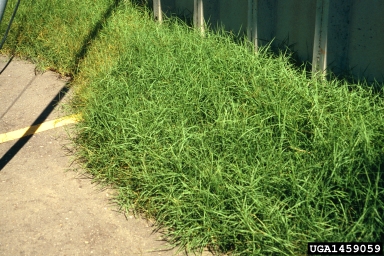Cynodon dactylon
Bermudagrass
Synonym(s): Capriola dactylon, Panicum dactylon, Cynodon aristiglumis, and Cynodon incompletus
Family: Poaceae (Grass Family)
Duration and Habit: Perennial Grass/Grasslike

Photographer: Steve Dewey
Source: Utah State University, Bugwood.org
Description
Bermudagrass (Cynodon dactylon) is a popular commercial grass found in over 100 countries throughout the world. This sod forming grass is highly variable in appearance with stolons that root at the end of the nodes. From these nodes, lateral buds develop that produce stems measuring from 5 to 40 cm in height. Species within the genus Cynodon have characteristic leaves that give the appearance of multi-leaved nodes due to stems with long internodes that can alternate in length allowing for overlap with other stems. New shoots and roots are produced during and following the spring months. Mature roots are yellow or brown where young roots are white.
Ecological Threat: Listed as one of the three most troublesome weeds in crops such as: surgarcane, cotton, corn and vineyards, bermudagrass is difficult to eradicate once established due to deep rhizomes and rapid reproduction rate. Massive spread is facilitated by the broad genetic variability it possess by being a tetraploid. This allows bermudagrass to be highly fertile and become established in a broad range of habitats.
Biology & Spread: Cynodon dactylon is the only species from this genus that can reproduce from the seed. Other species require cultivation by stolons or rhizomes. Bermudagrass is one of the only turf grasses that is droubt tolerant due to it's ability to become semidormant during periods of unfavorable environmental conditions.
History: Bermudagrass was introduced to the United States in the early 1800's as a popular grass in the South for lawns and recreational fields. The exact time of introduction is not known, but records from Mease's Geological Account of the United States list bermuda grass as a principle grass in 1807.
U.S. Habitat: Climates that experience mild winters with temperatures that never fall below freezing with moderate to high rainfall similar to tropical and subtropical climates. Bermudagrass can grow in a variety of soils, but requires adequate amounts of sun and does not thrive in levels of low light.
Distribution
Native Origin: Africa or India
U.S. Present: All states with the exception of the Northern most states due to temperature intolerance of bermudagrass.
Texas: Established throughout the state.
Management
Although bermudagrass can be a nuisance in agricultural settings, it is widely used in lawns and sports fields such as golf courses in the Southern United States.
In places where bermudagrass is not desired and considered a weed, grass pesticides (such as Roundup) can be utilized for removal, but may require more than one application. It is important to research other crops or grass types surrounding the bermudagrass to avoid damage. If manual removal is preferred, take care to remove the entire plant including the roots because this will allow for regeneration in that area. Typically, just pulling bermudagrass is ineffective for eradication.
Text References
Harlan, Jack R., and J. M. J. de Wet. 1969. Sources of variation in Cynodon dactylon (L). Crop Science 9(6): 774-778.
Internet Sources
http://aggie-horticulture.tamu.edu
 Texas Invasive Species Institute
Texas Invasive Species Institute